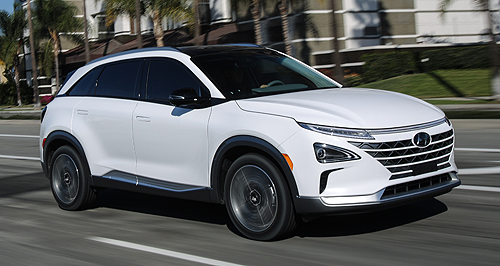News - HyundaiHyundai plans to build local FCEV networkNex level: Hyundai is looking to accelerate the rollout of fuel-cell charging infrastructure to support vehicles such as the Nexo SUV. Discussions between Hyundai and energy giants to hopefully start fuel-cell network29 Oct 2018 HYUNDAI Motor Company Australia (HMCA) is currently in discussion with a number of large global energy companies to develop a hydrogen fuel-cell vehicle (FCEV) charging network, following the opening of a battery-electric network last week.
The Chargefox infrastructure project was launched at a site in Euroa, Victoria on Thursday, attended by representatives Mercedes-Benz, Jaguar Land Rover, Audi and Hyundai, all of whom were involved in backing the EV charging network.
Speaking to GoAuto at the launch of the Chargefox network, Hyundai Motor Company Australia (HMCA) manager of future mobility and government relations Scott Nargar said the company “definitely” has plans to develop an FCEV charging network to rival that of Chargefox.
“Definitely, we know of a couple of stations that will be online next year and we know that the ACT station will more than likely be the first, and Hyundai has already got 20 of the next-generation Nexo fuel-cell vehicles as part of that process,” he said.
“We have taken expressions of interest and people that want to order fuel-cell vehicles right now, and we’ve also got some fleet companies talking to us about their clients that are actually asking for fuel-cell vehicles, as they know of the projects that are going into several states.”
Mr Nargar said he could not elaborate on specific infrastructure projects, but indicated there were currently multiple projects in the early planning stages in different states.
“Not at the moment because they haven’t been announced by the project proponents, but we know there are projects going to happen in Queensland, we’re looking at stuff happening in New South Wales, the ACT especially, South Australia there’s some projects happening and also Western Australia.”
In August, the CSIRO made a major breakthrough in fuel-cell technology by developing a way to transport hydrogen through liquid ammonia instead of gaseous hydrogen, which would require high-pressure tank storage and costly storage infrastructure.
Mr Nargar said the members of Hydrogen Mobility Australia (HMA), including major gas and energy companies, saw the development as not only a way of increasing the rate of FCEV introduction in Australia, but as an export opportunity.
“You look at the breadth of the hydrogen mobility membership when you’ve got state government representatives from those states, you’ve got the CSIRO and then the paying members are all the oil companies – BP, Caltex, Beep Energy, Shell, BOC, Lindy, Air Liquide, Siemens … Austin Energy, AGIG gas networks – these are the big energy/gas retailers in Australia, or energy distributors or wholesalers, that are part of hydrogen mobility,” he said.
“They want to use the technology, use renewable energy to make hydrogen, it will help balance the grids, we can inject it into the gas pipeline, we can export ammonium hydrogen overseas.
“Our northern neighbours want a whole lot of that and Hyundai has been part of those discussions with the Australian government and Austrade and the Korean and Japanese governments.
“There’s a global want for our green energy and we have to make sure we use our green energy for our transport networks at home as well as what we’re going to ship overseas.
With companies such as BP and Shell as HMA members, Mr Nargar suggested that Australian fuel stations may follow those in Europe and North America by installing FCEV charging stations at petrol stations.
“We’re looking at some projects now where you’ve got a lot of the big stations around Australia (that) are removing the LPG bowsers from the site, and also the big sites like here at Euroa where there’s a lot of space on the land, this is an easy place to deploy infrastructure and this is where infrastructure is needed, between big cities and regional centres,” he said.
“But you also need infrastructure in the cities, so we know that gas companies are looking to sell hydrogen on their own gas-company-branded sites, we’ve got energy resources companies looking to do the same thing, and you’ve got oil companies who, overseas, have already got hydrogen stations on their forecourts in Europe and North America.
“Most of the stations I use in Europe and North America – particularly in Germany – they’re all Shell stations, they’re already doing it. We just need to make sure that they’re rolling over that technology to Australia so we can start to deploy it here.”
Overseas petrol stations are also starting to invest in EV charging, such as BP, which, in the UK recently bought Chargemaster, the country’s largest EV charging company, with plans to set up more than 6500 charging points.
When asked by GoAuto if the petrol giant had any plans for a similar initiative in Australia, a spokesperson said: “In Australia we are watching this initiative with a lot of interest. We are continually reviewing and accessing potential solutions to meet our changing customer demand and supporting opportunities for customers to reduce their emissions.”  Read more8th of August 2018  CSIRO makes hydrogen breakthroughNew CSIRO membrane set to transform hydrogen transport via liquid ammonia22nd of June 2018  Audi and Hyundai team up for FCEV techHydrogen fuel-cell electric vehicle parts to be shared between Audi and Hyundai |
Click to shareHyundai articlesResearch Hyundai Motor industry news |
















Facebook Twitter Instagram